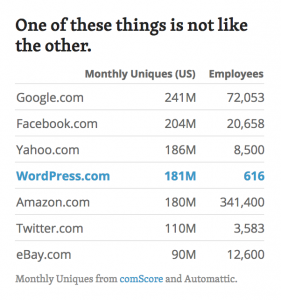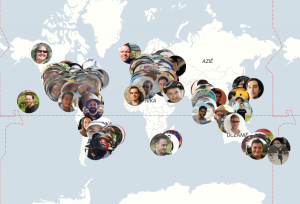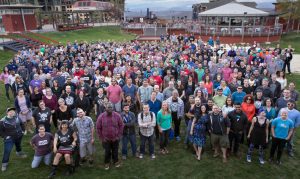
Finding the right talent is currently the biggest challenge for successful IT organizations. How do they manage this? The story of WordPress developer Automattic is truly inspiring.
The organization behind WordPress
Automattic is the company behind the popular WordPress platform. This is an open-source content management system (CMS) widely used for developing websites. WordPress’s vision is to democratize publishing so that anyone with a story can share it—regardless of income, gender, political beliefs, language, or location. They are strong advocates of the open source principle. Currently, a staggering 27.5% of the world’s top 10 million websites use WordPress. With around 60 million websites, it is by far the most popular website management system. Remarkably, they manage all this with just 616 employees. The chart below shows how this compares to other companies that rely on website traffic.

Automattic is a successful, fast-growing IT organization that should face major challenges in filling vacancies with scarce IT talent. Yet they manage to succeed. It’s fascinating to hear what choices they’ve made and how they’ve found success.
Distributed organization

The key lies in their decision to operate as a distributed organization. Automattic employees (they call them Automatticians) work from all over the world. They now have 616 employees in 57 countries, speaking no fewer than 80 different languages.
Remote Working
Everyone works from the location of their choice: remote working. Another major advantage: thanks to their global distribution, they are active 24/7. Meanwhile, collaboration takes place via blogs, private chat rooms, and Slack. At Automattic, it doesn’t matter how many hours you work—what counts is the result.
Global Meetup

Every year, Automattic organizes a seven-day gathering: a Global Meetup where everyone comes together to strengthen connections. They usually pick a beautiful location for this, such as: San Francisco, California; La Paz, Mexico; Seaside, Florida; Budapest, Hungary; Santa Cruz, California; or Whistler, Canada. Additionally, individual teams often meet at specific locations around the world. If you work at Automattic, you should expect to travel three to four weeks per year.
Employment Conditions

What does a distributed organization need to provide for its employees? Automattic offers benefits such as: an open vacation policy (no fixed number of vacation days per year), reimbursement for setting up a good home workspace, necessary hardware, insurance coverage, full reimbursement for all global travel expenses, open parental leave (if you've worked at Automattic for more than 12 months, it's fully paid), and a paid three-month sabbatical every five years.
What are the drawbacks?
So, is this the solution for successful Dutch IT organizations? I know a few that are already using this model. The main thing people miss is the ‘daily chat by the coffee machine’. Of course, you also miss much of what happens on the office floor. But is that insurmountable? I’m curious. Who can share successful examples of remote working in Dutch organizations? Raymond te Veldhuis CheckData & DataJobs.nl

